6.7 Doors, windows and glazing
SITEWORK STANDARDS
| 6.7 - S1 | Sitework standards |
| 6.7 - S2 | Protection against damp |
| 6.7 - S3 | Location and fixing |
| 6.7 - S4-S5 | Glazing |
| 6.7 - S6 | Protection |
(a) meet the Technical Requirements
(b) take account of the design
(c) follow established good practice and workmanship
Sitework that complies with the design and the guidance below will be acceptable for doors, windows and glazing.
PROTECTION AGAINST DAMP
Items to be taken into account include:
(a) priming
Material to be painted should be primed before fixing. Material to be stained should have the first coat applied before delivery to site. Any material delivered untreated should be treated promptly.
Neither primer nor the first coat prevent joinery from taking in moisture.
(b) storage
When joinery is stored on site, precautions should include:
- avoiding wetting during unloading
- stacking external joinery on bearers off the ground and covering with waterproof material
- storing internal joinery in a weather-protected condition.
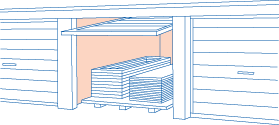
Joinery which is not properly stored or protected may not meet Technical Requirement R3.
LOCATION AND FIXING
Items to be taken into account include:
(a) weathertightness
Doors and windows should be installed correctly so they perform satisfactorily in use.
Dpcs should be correctly installed.
The dpc should extend approximately 25mm into the cavity. If a thick block is used to close the cavity and form the reveal, a wider dpc will be required.
Vertical dpcs should extend continuously to the full height of the frame.
In Scotland, Northern Ireland and areas of Very Severe exposure in England, Wales and the Isle of Man, 'check' reveals should be used. Additionally, an appropriate sealant is required between doors and windows and masonry.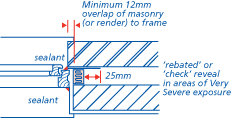
(b) fixing
Window frames and linings should be fixed solidly, level and plumb and should be either:
- secured by door/window cramps, or
- plugged and screwed.
Fixings should be not more than 600mm apart and not more than 150mm from top or bottom. Alternative locations and fixings are acceptable as long as they provide the same structural stability.
When driving wedges or other fixings, frames or other components should not be distorted.
Frames and linings should fit tightly into openings and be blocked or packed out at fixing points, where necessary.
Frames for external elements should be located in openings so that the head of the frame is protected by the lintel, and throatings in sill members are not obstructed by the wall face.
In Scotland, Northern Ireland and areas of Very Severe exposure in England, Wales and the Isle of Man, it is not acceptable to fix window frames in the outer leaf of external walls.
(c) bay windows
To prevent sagging and bowing, bay and bow type windows should be adequately supported and secured to the structure to prevent casements becoming twisted.
Bay windows should be properly linked to dpcs at reveals.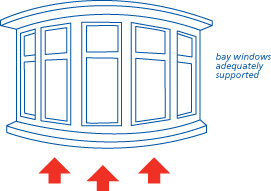
(d) cut ends
Where pre-treated joinery is cut or adjusted on site, the affected surfaces should be re-treated with two flood brush coats of appropriate preservative.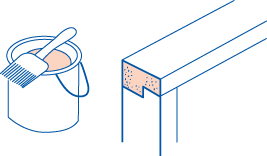
(e) window boards
The top surface of window boards should be flat and level. Boards should be fixed close to the frame and adequately secured against twist and other movement, particularly any back slope towards the frame.
Medium density fibreboard should be moisture resistant grade.
(f) hanging doors and opening lights
Opening lights and door leaves should hang square within the frame or lining and fit neatly with minimum gaps, subject to the requirements of effective weatherstripping. Doors to bathrooms and WCs with mechanical ventilation should be hung with a gap at the bottom or be fitted with a ventilation grille.
Where a standard flush door is reduced in height, the bottom rail should be replaced if necessary. The leading edges of doors should be protected with timber lipping, where necessary.
(g) general ironmongery
Where required, hinges and other ironmongery should be housed neatly flush with the surface.
The full complement of matching screws should be provided and properly screwed home.
Locks should not be fitted in mortices too tightly and keyholes should be aligned and locks should turn easily. The clearance between a door handle and a door stop should be at least 25mm.
(h) door hinges
To reduce twisting, doors should be hung on hinges as follows:
| Type of door | Hinges |
| External | 1½ pairs x 100mm |
| Fire door | 1½ pairs* x 100mm |
| Airing or cylinder cupboard | 1½ pairs x 75mm |
| Other internal | 1 pair x 75mm |
| * 1 pair where rising butts are used | |
(i) security
Security items for doors and windows are contained in Clause D4.
(j) workmanship
Internal door frames and linings should be of the correct widths to match the wall or partition thickness, including finish.
Frames and linings should be blocked off walls, wherever possible, to allow for full architraves.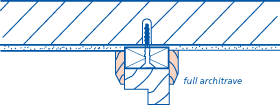
All timber trim should be:
- sufficiently wide to mask joints, and
- fixed so as to minimise movement and shrinkage.
Architraves should be:
- parallel to frame and lining arrises
- accurately mitred or scribed to fit tightly and neatly
- fixed with an equal margin to each frame member
- fixed securely together with linings to prevent curling.
Nails should be punched below the surface of the timber and holes stopped. Nails should not be driven home with the hammer head. Damage should be avoided where easing is necessary. Any damage should be made good.
(k) finish upon completion of work
Work should be left in a clean state and brought to an appropriate level of finish for other trades.
Finishing trades should not be relied upon to correct untidy work.
GLAZING
Glass and insulating glass units should be inspected for visual defects and defects which could lead to premature failure.
Often, defects are caused by:
- water accumulating between sheets, which may cause surfaces to become marked, and
- edge damage or scratching.
Items to be taken into account include:
Sufficient space should be provided between the glass edge and the frame to allow for thermal expansion of the glass. A gap of 3mm is recommended, except for drained systems where at least 5mm is required for drainage at the bottom bead. Insulating glass units should not be cut or punctured in any way on site.
When cutting single sheets of glass or plastics for windows, an allowance should be made for thermal movement of the pane, taking into account:
- the material being used, and
- the size of the pane.
This allowance is especially important when window rebates are shallow, allowing limited tolerance for expansion of the glazing.
Before glazing, rebates should:
- have been primed (for timber frames),
- be rigid and true, and
- be of the correct size for the glazing. Insulating glass units should be properly protected by the frame from sunlight. The spacer bar of the insulating glass unit should always be below the level of the frame's sightline.
Setting and location blocks should be of a suitable resilient material. In drained and ventilated frames the drainage channels in the rebate should be free from obstructions that prevent effective drainage. The dimensions of holes and slots should be checked to ensure that effective drainage can occur.
Beads and linings should be used for:
- all internal glazing
- other locations where shock absorption properties are required.
Beads should be used:
- where doors or windows are to be finished with water-borne stains
- where fully bedded systems are used to install insulating glass units
- where glazing takes place on site, the bottom bead should be drained and vented.
Beads should be fixed at not more than 150mm centres.
All materials should be compatible and used in accordance with the manufacturer's recommendations. Materials from different manufacturers should not be used together unless both have agreed in writing.
Unless factory glazed, insulating glass units should be installed in accordance with the design. In timber frames where solid bedding methods are to be used on site, the bottom bead should be drained and vented.
Insulating glass units and any accompanying documentation should be checked to ensure that they comply with the design. The insulating glass units should carry a CE mark to BS EN 1279 and have a third party assessment certificate such as the BSI Kitemark. The glass type, gas filling, edge seal type and dimensions should be checked against the documentation and the insulating glass unit itself.
Where doors and windows of materials other than timber are delivered to the site unglazed, the glazing should be carried out in strict accordance with the manufacturer's instructions.
Appropriate fixing and sealing systems should include:
- distance pieces, unless load bearing tapes are used
- setting blocks
- location blocks where required
- appropriate beads
- glazing compounds, sealants, gaskets and/or capping.
PROTECTION
Keep internal doors covered with polyethylene or original wrapping.
Door frames and linings should be protected with timber strips or plywood to at least 1m above skirting level. Thresholds and window sills should be covered. Scaffolding and walkways should be kept away from frames.
Joinery should be protected from paint splashes and other damage.
All temporary coverings should be removed after all other work has been completed, before handover.





















